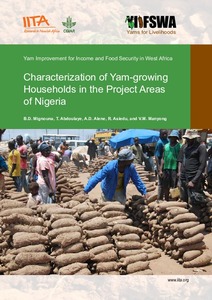| dc.contributor.author | Mignouna, Djana B. |
| dc.contributor.author | Abdoulaye, Tahirou |
| dc.contributor.author | Alene, A. |
| dc.contributor.author | Asiedu, Robert |
| dc.contributor.author | Manyong, Victor M. |
| dc.date.accessioned | 2019-12-04T11:08:18Z |
| dc.date.available | 2019-12-04T11:08:18Z |
| dc.date.issued | 2014 |
| dc.identifier.citation | Mignouna, B.D., Abdoulaye, T., Alene, A., Asiedu, R., & Manyong, V. M. Characterization of Yam-growing Households in the Project Areas of Nigeria. Ibadan, Nigeria: IITA. |
| dc.identifier.isbn | 978-978-8444-46-6 |
| dc.identifier.uri | https://hdl.handle.net/20.500.12478/1787 |
| dc.description.abstract | The Yam Improvement for Income and Food Security in West Africa (YIIFSWA) project was initiated to assess and understand the yam-based systems in order to identify the opportunities of interventions that could potentially help to increase productivity in the region. The project consists of two phases: the inception phase and impact study phase. During the inception phase, a baseline study was conducted in different yam-growing communities aggregated on agroecological zoning into the southern Guinea savanna (SGS), the derived savanna (DF), and the humid forest (HF). A complementary baseline survey was commissioned in addition to the substantive data collected within the same yam belt of Nigeria aiming at measuring directly yam yield from farmers’ fields in order to get more accurate crop yield estimates. The baseline studies aimed at understanding farmers’ livelihoods in yam-growing areas to increase agricultural productivity in Nigeria and also to serve as benchmarks to assess changes brought about by the YIIFSWA project in future. The goal of the baseline surveys was to measure the key economic and social indicators before implementing the major components of the project.Data was collected by means of structured questionnaire and a set of qualitative interview questions for focus group discussions to capture household and community specific information. The main survey design was based on a multistage, random sampling procedure, drawing on the universe of households from yam growing areas of Nigeria. A random sampling procedure was used to select 800 households within the yam belt. |
| dc.format.extent | 1-92. |
| dc.language.iso | en |
| dc.subject | Data Collection |
| dc.subject | Instruments |
| dc.subject | Data Analysis |
| dc.subject | Yams |
| dc.subject | Households |
| dc.subject | Yiifswa |
| dc.subject | Farmers' Livelihoods |
| dc.title | Characterization of yam-growing households in the project areas of Nigeria |
| dc.type | Book |
| dc.description.version | Peer Review |
| cg.contributor.crp | Roots, Tubers and Bananas |
| cg.contributor.affiliation | International Institute of Tropical Agriculture |
| cg.coverage.region | Africa |
| cg.coverage.region | West Africa |
| cg.coverage.country | Nigeria |
| cg.authorship.types | CGIAR single centre |
| cg.iitasubject | Yam |
| cg.journal | Yam Improvement for Income and Food Security in West Africa |
| cg.howpublished | Formally Published |
| cg.accessibilitystatus | Open Access |
| local.dspaceid | 83239 |

